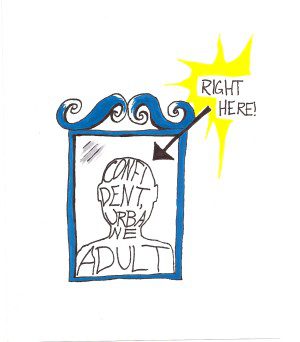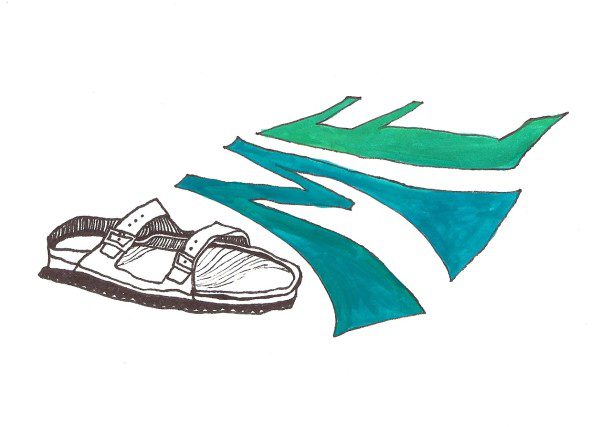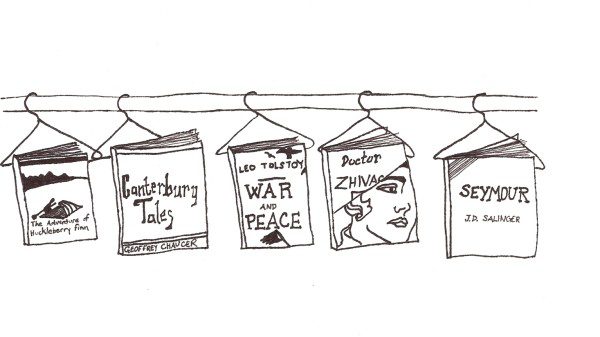Like a lot of men these days, the line between what I wear to go to work, to work out, and to sleep has gotten dangerously thin. I spend most evenings and weekends in pajama pants or sweatpants, T-shirts, and hoodies. For heading out in the world, I usually switch into a boxy, untucked, retro-looking shirt; a well-worn cardigan; soft, baggy linen pants; and Nikes or Vans. The look I hope I’m pulling off: Kramer on Seinfeld meets Kurt Cobain on MTV Unplugged. The look I worry I’m projecting: an all-too-middle-aged guy masquerading as a middle-school skate punk.
Of course, the fact that I’m even talking about having a “look” is ridiculous, since there’s no indication that anyone is giving my clothes a glance. As a married, fiftysomething writer who works most days from home, there’s no one checking me out in a bar or club, no fashion police waiting to write me up. And yet here I am trying on a porkpie hipster hat in a consignment store, flipping through the board shorts in the Shaun White section at Target, putting together an outfit that I hope looks like I didn’t spend time putting together an outfit.
On the rare occasions these days that I do have to dress up as an age-appropriate adult, I realize just how poorly equipped I am for the part. It’s one thing to not own a cuff link, tie clip, or cummerbund; it’s another to forget how to tie a tie or to how to iron a shirt without burning it up. When I’m invited to an out-of-town wedding or work retreat, I panic: the only way I could pull a weekend’s worth of “business casual” outfits out my closet would be if my business were operating a carnie ride or playing a part on Star Trek.
As a little kid, I don’t remember ever thinking or talking about clothes. My parents, to their credit, weren’t the types to dress us up for show or to give us rules about what we could or couldn’t wear. I’d assume this lack of fashion instruction was typical, at least for males, except that I keep coming across interviews and essays by men who connect the way they dress to their father’s early influence. This is certainly true for Gay Talese, who has often talked about how his style as a dresser and as a writer was deeply influenced by his tailor father. It’s true, too, for Tom Junod, whose celebrated GQ essay “My Father’s Fashion Tips” describes father-son conversations about clothes so different from my own that I felt I was reading about an unrecognizable culture—or planet. A father who calls his son into the bathroom to teach him the proper way to de-lint his belly button? Who insists a man should “always wear white to the face”? Who has strong opinions about tans, turtlenecks, cuffs? Now my own father, a Freudian psychoanalyst, has strong opinions about lots of things—“There’s no such thing as an accident” and “There are no easy Oedipal victories” are two of his favorite sayings—but I never heard him say a single thing about fashion, unless you count “Never buy retail.”
As a teenager in—and a product of—the ’60s, I was desperate to dress in a way that would differentiate me from “the man,” which included not just cops and politicians, but also all those fathers rushing to the commuter train in their gray flannel suits and all those jocks strolling down the high-school hallways in their letter sweaters and chinos. My fashion goal was to identify myself as a “freak” (we never described ourselves in those days as hippies). This meant I wore a colorful tie as a headband to set off my black, crazy-curly, well-beyond-shoulder-length hair, and I dressed in one of these four outfits: (1) a white one-piece jumpsuit with a red Ted’s Texaco insignia stitched onto the front pocket and tan, worn-in “construction boots,” (2) a white buttonless open-necked, muslin Mexican shirt with colorful embroidery; baggy, beige, cotton drawstring pants; and huarache sandals with tire-treaded soles, (3) Oshkosh overalls and a faded, flannel shirt, or (4) blue jeans, cowboy boots, and a Western plaid dress shirt with snaps.
Somehow it never occurred to me that each one of these outfits was normally, or at least originally, worn by a particular kind of manual laborer: auto mechanic, Mexican peasant, American farmer, ranch hand. You’d think that as someone who never did much of any labor, manual or otherwise, I might have felt self-conscious playing this kind of dress-up. But that thought never crossed my mind. For one thing, the girls I was trying to impress were also dressed like Mexican peasants—except when they dressed like gypsy fortune-tellers. For another thing, I was convinced that the way I dressed was proof that I was part of the resistance (even though I was an overprivileged, suburban kid), that I was arty (even though I didn’t do any art), and that I was a free thinker (even though I was dressed like a whole lot of other suburban kids who all wished that we had made it to Woodstock instead of just seeing the movie).
The mechanic outfit came from the Salvation Army store in my upscale suburban town; the overalls and cowboy gear I got at a “Western wear” store in the city. The Mexican clothes, on the other hand, actually came from Mexico. I got them the summer I turned sixteen. My parents had dragged my brothers and me there for a summer vacation. A temperamental teenager (my moods swung all the way from sullen to angry), I was not happy to be trapped for three weeks with my noticeably middle-aged, middle-class parents. Fortunately, though, that trip rendered some unexpected pleasures. First, I got to see my father, a man who seemed to believe that every illness or injury that my brothers and I suffered was a psychosomatic sign of weakness and neurosis, experience such serious food poisoning that no matter where he was—hotel lobby, museum, public park—he had to lie down and bunch himself into a little ball. I know it is heartless to derive pleasure from another human being’s suffering, but after all those times my father had shot me a look of skepticism when I complained of a headache or stomach cramp or, once, a broken collarbone, I just saw this as an instance of the chickens—or, in this case, of the pollo con mole—coming home to roost.
But the delight of seeing my always-in-control father out of control didn’t end with this “Montezuma’s Revenge meets my Oedipal complex” moment; there was also the morning that he got up early and headed out to explore the neighborhood near the hotel. Passing a barbershop, he had a sudden impulse to see how he’d look with a Mexican shave and haircut. Trying to explain what he wanted to a barber who spoke as little English as he spoke Spanish proved to be difficult, and all he could come up with was: “A trim? You know, a haircut but not too short. A trim? El trimo?”
The barber, not understanding a word my Dad spoke, asked, “El trimo? Como Yul Brynner?”
To which my father, for reasons he still can’t explain, responded “Sí, sí, como Yul Brynner, except not that short.”
The sight of his shiny-as-a-ping-pong-ball shaved head as he walked into the hotel restaurant generated ruthless laughter from me and my brothers and a Spanish Inquisition level of browbeating from my mother who kept saying, “What were you thinking?”
The other good thing that came out of the trip was that my brother Joe and I picked up those great peasant shirts and huarache sandals that were to become the centerpieces of our back-to-school wardrobes. (My younger brothers, Jeff and Dan—nine and eleven at the time—also came back with complete outfits, but unfortunately theirs turned out to a little less practical: except for the occasional Halloween party or sword fight, when can a little suburban Jewish kid wear an authentic, beautifully embroidered matador costume?) If there is any blessing at all in my decision to culturally cross-dress as a migrant worker from Guanajuato, it’s that this was still a generation before every lawn in my town was being mowed, weeded, and seeded by Mexican Americans. Since the gardeners in those days were all recently arrived Italian immigrants, I’m just grateful that I didn’t head off to a school dressed as a Sicilian fisherman.
By the time I got to college and took up the study of literature, I had moved on to outfits inspired by literary characters. (This, at least, was one fashion affectation I came by honestly: when I was six, my mother sent me out for Halloween dressed as Huck Finn; at seven, she convinced me to go as the Pardoner from the Canterbury Tales.) I spent my college autumns and springs in full-out Tolstoyan peasant regalia; in the winter, I adopted a Dr. Zhivago-like, floor-length, army coat topped off by a fur hat; and on hot summer days I wrapped myself in a long bathrobe like the one Salinger’s suicidal hero, Seymour Glass, wore to the beach.
By my early twenties, I had moved on to grad school in English literature, where I took up wearing tweed sports coats, pleated woolen pants, and button-down shirts. I wasn’t alone in this style: I was surrounded by dozens of other children of impoverished, European immigrants all dressing like we were gentlemen in a Henry James or E.M. Forster novel. I never felt totally like myself in those clothes, but that was the point: like Laurence Olivier, who said he couldn’t bring a character to life until he located and then wore the right clothes, I was dressing up in those outfits in order to convince myself, as well as the people around me, that I could play the part of a confident, urbane adult.
Of course, outfitting yourself each day for a Merchant Ivory film can get tiring, uncomfortable, and expensive, and eventually I gave up the look. When I try to remember what came next, what I wore during my thirties and forties, I draw almost a total blank. I vaguely remember going through a corduroy stage. I have a bad feeling that I may have owned some too-tight, ’80s workout suits, and I think that there was a long period when I adopted that too-cool-for-school professor’s uniform of blue jeans, worn in to the point of a worn-out sports coat, and an ironically loose and un-pulled-up tie. But like I said, when it comes to my fashion choices of that period, my memory is pretty foggy. All I know for certain is that at some point, I stopped thinking of fashion as a statement—or even as a question or clause—and eventually started not thinking about it at all.
In retrospect, this all makes sense. This was during a time when my wife and I were completely immersed in raising our two daughters and in launching our careers—she as an editor and painter, I as a writer and teacher. In other words, this was a time when I had much bigger and better things to focus on than how I dressed, not to mention a time when I had smaller and smaller amounts of energy and money to spend.
What’s weird, then, is not that I stopped thinking of fashion for all those years but that when I turned fifty, I started thinking about it again. My rediscovered interest in what I wore grew not out of a full-blown midlife crisis but rather out of a three-quarter-life stocktaking. After years of focusing on kids and career, I suddenly looked around and realized that something—or rather, everything—had shifted. Our probably too-doted-on daughters, now long grown and gone, had let me and my wife know that it would be healthier for all parties concerned if we could learn to be a little less dependent on them for our entertainment, happiness, and reason to live; my desperately sought-after tenured professorship had started feeling less like the “academic freedom” it was advertised to be and more like a life sentence in a low-security facility; every week seemed to bring the first inklings of some new middle-age health concern; and the problems I was talking about in therapy the day before started sounding eerily like the problems I was talking about in therapy the decade before.
I realized that if I wanted to not feel like things were winding down, I needed to start amping them up. Since I couldn’t think of any new hobbies or passions to take up, I forced myself to go back to my old ones: recreational sports, recreational drugs, Woodstock-like festivals and rock-music clubs, even some random acts of juvenile delinquency, like buying a ticket to a megaplex theater and then sneaking into one or two or (once) even four other movies. And, taking my cue from T. S. Eliot’s J. Alfred Prufrock, who, disgusted by his own midlife timidity, decides he better bust out a new style (“I grow old… I grow old… / I shall wear the bottoms of my trousers rolled”), I realized that I also needed to shake things up on the fashion front.
My initial attempts at reinventing myself were, I now realize, absurdly awkward. I found myself waiting in line to get into late-night music clubs where I was the only one who didn’t need a fake ID, asking my friends if they thought their kids might be willing to sell me some weed, growing my ever-thinning hair longer and longer, and dressing in clothes that made my family and friends do double takes. I still wince when I think about the time on family vacation in Florida that I came down to breakfast in a brand-new, sky-blue, baggy Fubu top, blue jean shorts so long they looked like pants that were too short, and fluorescent green, suede Sketchers. On cue, my wife and daughters broke out in crazy laughs, certain that I had put this outfit together as a sight gag for their benefit. Since I am the same guy who almost fell off my chair when I saw my father walk into that other hotel restaurant sporting his Brynner dome, I definitely had this coming.
But in spite of those awkward moments, this second adolescence has still been easier than my first one. For one thing, I don’t have to spend all my time thinking about how to convince my high-school girlfriend to give up all of her other friends and activities in order to focus on us (which, I now realize, meant me), or, as soon as that worked, figuring out how to tell her that we have to break up because I’m suddenly feeling smothered and claustrophobic. For another thing, I am far less self-conscious than I used to be. Maybe I’ve figured out that no one else really cares. Maybe all that therapy has sunk in. Or maybe, this late in the run, I’ve finally gotten the hang of playing myself.
I realize, of course, that being comfortable in my own clothes is no great achievement or noble deed, though it’s probably as close as a self-aware, highly therapized Jew can ever get to being “comfortable in one’s own skin.” Maybe all I’ve done is turn myself into a walking Onion story (“Area Man Finally Finds His Fashion Sense in His 50s”), but I can’t deny that closing the gap between the self I project to the world and the self I experience myself to be feels like some kind of personal progress or passage. I’ve already told my wife to stop me—or shoot me—before I turn into one of those middle-aged guys you see walking into a nice restaurant dressed like a little kid in a tank top, gym shorts, and baseball cap. In the meantime, though, I’ve decided to think of this as a step—albeit a well-worn, Birkenstocked step—in the right direction.
***
Rumpus original art by Annie Daly.
Listen to Lad read his essay:







One response
An issue I’ve thought about a bit myself lately. I think it simply boils down to the fact that we’ve, worldwide, in developed nations anyway, become more superficial and more consumerist. People who are legitimately interested in ‘fashion,’ who actually spend time thinking about this stuff, are often tremendously banal. And we could get into gender and homosexuality and why certain people are encouraged to follow fashion (women and gays) and other people are encouraged not to (straight men) but I personally just can’t take someone who knows a lot about clothes all that seriously. Knowing a lot about the mechanics of cars, or about literature/books, or about art or music or sports; it all seems much more sensible and a better use of one’s time. Caring about appearance or judging people based on how they dress being seen anything other than deplorable is probably a result of the overall more narcissistic swing in society, especially in the younger generations but in the reality TV level fame-chasing impulse that is encouraged in adults now as well. Kramer shopped in thrift shops. Kurt Cobain would not care about thread counts or what material something was made out of or what of-the-moment fashionista is putting his name on a jacket or a shirt.
Click here to subscribe today and leave your comment.